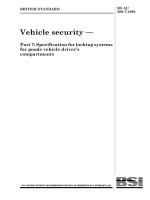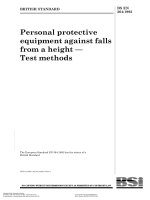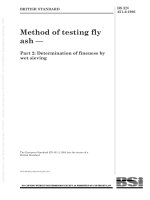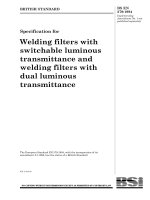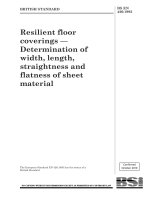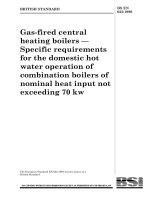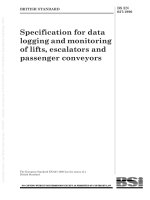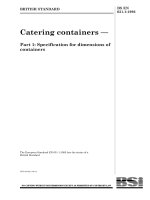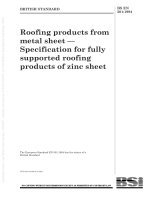Bsi bs en 20105 c03 1993 (1999)
Bạn đang xem bản rút gọn của tài liệu. Xem và tải ngay bản đầy đủ của tài liệu tại đây (349.01 KB, 10 trang )
BRITISH STANDARD
Textiles — Tests for
colour fastness —
Part C03: Colour fastness to washing:
Test 3
The European Standard EN 20105-C03:1992 has the status of a
British Standard
UDC 677.074/.077:677.016.47:620.1
BS EN
20105-C03:
1993
ISO 105-C03:
1989
BS EN 20105-C03:1993
Cooperating organizations
The European Committee for Standardization (CEN), under whose supervision
this European Standard was prepared, comprises the national standards
organizations of the following countries:
This British Standard, having
been prepared under the
direction of the Textiles and
Clothing Standards Policy
Committee, was published
under the authority of the
Standards Board and comes
into effect on
15 January 1993
© BSI 08-1999
The following BSI references
relate to the work on this
standard:
Committee reference TCM/25
Special announcement in
BSI News January 1992
ISBN 0 580 20891 5
Austria
Oesterreichisches Normungsinstitut
Belgium
Institut belge de normalisation
Denmark
Dansk Standardiseringsraad
Finland
Suomen Standardisoimisliito, r.y.
France
Association franỗaise de normalisation
Germany
Deutsches Institut für Normung e.V.
Greece
Hellenic Organization for Standardization
Iceland
Technological Institute of Iceland
Ireland
National Standards Authority of Ireland
Italy
Ente Nazionale Italiano di Unificazione
Luxembourg
Inspection du Travail et des Mines
Netherlands
Nederlands Normalisatie-instituut
Norway
Norges Standardiseringsforbund
Portugal
Instituto Portugs da Qualidade
Spain
Asociación Espola de Normalización y Certificación
Sweden
Standardiseringskommissionen i Sverige
Switzerland
Association suisse de normalisation
United Kingdom
British Standards Institution
Amendments issued since publication
Amd. No.
Date
Comments
BS EN 20105-C03:1993
Contents
Cooperating organizations
National foreword
Foreword
1
Scope
2
Normative references
3
Principle
4
Apparatus and reagents
5
Test specimen
6
Procedure
7
Test report
8
Notes
National annex NA (informative) Committees responsible
National annex NB (informative) Cross-references
Table 1 — Single-fibre adjacent fabrics
© BSI 08-1999
Page
Inside front cover
ii
2
3
3
3
3
4
4
4
4
Inside back cover
Inside back cover
4
i
BS EN 20105-C03:1993
National foreword
This British Standard has been prepared under the direction of the Textiles and
Clothing Standards Policy Committee. It is the English language version of
EN 20105-C03:1992 Textiles — Tests for colour fastness — Part C03: Colour
fastness to washing: Test 3 published by the European Committee for
Standardization (CEN), which is identical with ISO 105-C03:1989, published by
the International Organization for Standardization (ISO).
The technical content of this British Standard is identical with that of the
corresponding method in BS 1006:1990 Methods of test of colour fastness of
textiles and leather.
A British Standard does not purport to include all the necessary provisions of a
contract. Users of British Standards are responsible for their correct application.
Compliance with a British Standard does not of itself confer immunity
from legal obligations.
Summary of pages
This document comprises a front cover, an inside front cover, pages i and ii,
the EN title page, pages 2 to 4, an inside back cover and a back cover.
This standard has been updated (see copyright date) and may have had
amendments incorporated. This will be indicated in the amendment table on the
inside front cover.
ii
© BSI 08-1999
EUROPEAN STANDARD
EN 20105-C03
NORME EUROPÉENNE
November 1992
EUROPÄISCHE NORM
UDC 677.074/.077:677.016.47:620.1
Descriptors: Textiles, dyeing, dyes, dyeing tests, colour fastness, washing tests, soaps, reference sample
English version
Textiles — Tests for colour fastness
Part C03: Colour fastness to washing: Test 3
(ISO 105-C03:1989)
Textiles — Essai de solidité des teintures —
Partie C03: Solidité des teintures au lavage —
Essai 3 (ISO 105-C03:1989)
Textilien — Farbechtheitsprüfung —
Teil C03: Bestimmung der Waschechtheit von
Färbungen und Drücken —
Test 3 (ISO 105-C03:1989)
www.bzfxw.com
This European Standard was approved by CEN on 1992-11-09. CEN members
are bound to comply with the CEN/CENELEC Internal Regulations which
stipulate the conditions for giving this European Standard the status of a
national standard without any alteration.
Up-to-date lists and bibliographical references concerning such national
standards may be obtained on application to the Central Secretariat or to any
CEN member.
This European Standard exists in three official versions (English, French,
German). A version in any other language made by translation under the
responsibility of a CEN member into its own language and notified to the
Central Secretariat has the same status as the official versions.
CEN members are the national standards bodies of Austria, Belgium,
Denmark, Finland, France, Germany, Greece, Iceland, Ireland, Italy,
Luxembourg, Netherlands, Norway, Portugal, Spain, Sweden, Switzerland and
United Kingdom.
CEN
European Committee for Standardization
Comité Européen de Normalisation
Europäisches Komitee für Normung
Central Secretariat: rue de Stassart 36, B-1050 Brussels
© 1992 Copyright reserved to CEN members
Ref. No. EN 20105-C03:1992 E
EN 20105-C03:1992
Foreword
This European Standard is the endorsement of
ISO 105-C03. Endorsement of ISO 105-C03 was
recommended by the Technical Committee
CEN/TC 248 “Textiles and textile products”, under
whose competence this European Standard will
henceforth fall.
This European Standard shall be given the status of
a national standard, either by publication of an
identical text or by endorsement, at the latest by
May 1993, and conflicting national standards shall
be withdrawn at the latest by May 1993.
The Standard was approved and in accordance with
the CEN/CENELEC Internal Regulations, the
following countries are bound to implement this
European Standard:
Austria, Belgium, Denmark, Finland, France,
Germany, Greece, Iceland, Ireland, Italy,
Luxembourg, Netherlands, Norway, Portugal,
Spain, Sweden, Switzerland, United Kingdom.
www.bzfxw.com
2
© BSI 08-1999
EN 20105-C03:1992
1 Scope
4 Apparatus and reagents
This part of ISO 105 specifies Test No. 3 of a series
of five washing tests that have been established to
investigate the fastness to washing of coloured
textiles and which between them cover the range of
washing procedures from mild to severe.
4.1 Suitable mechanical device (see clause 8),
consisting of a water bath containing a rotatable
shaft which supports, radially, glass or
stainless-steel containers 75 mm ± 5 mm in
diameter × 125 mm ± 10 mm high
of 550 ml ± 50 ml capacity. the bottom of the
containers being 45 mm ± 10 mm from the centre of
the shaft. The shaft/container assembly is rotated at
a frequency of 40 min–1 ± 2 min–1 The temperature
of the water bath is thermostatically controlled to
maintain the lost solution at the prescribed
temperature of 60 °C ± 2 °C.
4.2 Soap, containing not more than 5 % moisture
and complying with the following requirements
based upon dry mass:
— free alkali, calculated as Na2CO3: 0,3 %
maximum;
— free alkali, calculated as NaOH: 0,1 %
maximum;
— total fatty matter: 850 g/kg minimum;
— titre of mixed fatty acids prepared from
soap: 30 °C maximum;
— iodine value: 50 maximum.
The soap shall be free from fluorescent brightening
agents.
4.3 Soap solution, containing 5 g of soap (4.2)
and 2 g of anhydrous sodium carbonate per litre of
water ( 4.6).
4.4 Adjacent fabrics (see ISO 105-A01:1989,
sub-clause 8.3).
Either:
4.4.1 A multifibre adjacent fabric (TV) not
containing wool or acetate, complying with
ISO 105-F10, or, where specified, a multifibre
adjacent fabric (DW) containing wool and acetate,
also complying with ISO 105-F10. If multifibre
adjacent fabric (DW) is used, this shall be indicated
in the test report.
Or:
4.4.2 Two single-fibre adjacent fabrics, complying
with the relevant sections of F01 to F0B of
ISO 105-F:1985.
One of the adjacent fabrics shall be made of the
same kind of fibre as that of the textile to be tested,
or that predominating in the case of blends, and the
second piece made of the fibre as indicated in
Table 1 or, in the case of blends, of the kind of fibre
second in order of predominance, or as otherwise
specified.
NOTE 1 This method is designed to determine the effect of
washing only on the colour fastness of the textile. It is not
intended to reflect the result of the comprehensive laundering
procedure.
2 Normative references
The following standards contain provisions which,
through reference in this text, constitute provisions
of this part of ISO 105. At the time of publication,
the editions indicated were valid. All standards are
subject to revision, and parties to agreements based
on this part of ISO 105 are encouraged to
investigate the possibility of applying the most
recent editions of the standards indicated below.
Members of IEC and ISO maintain registers of
currently valid International Standards.
ISO 105-A01:1989, Textiles — Tests for colour
fastness — Part A01: General principles of testing.
ISO 105-A02:1987, Textiles — Tests for colour
fastness — Part A02: Grey scale for assessing change
in colour.
ISO 105-A03:1987, Textiles — Tests for colour
fastness — Part A03: Grey scale for assessing
staining.
ISO 105-F:1985, Textiles — Tests for colour
fastness — Part F: Standard adjacent fabrics.
ISO 105-F10:1989, Textiles — Tests for colour
fastness — Part F10: Specification for adjacent
fabric: Multifibre.
www.bzfxw.com
3 Principle
A specimen of the textile in contact with one or two
specified adjacent fabrics is mechanically agitated
under specified conditions of time and temperature
in a soap solution, then rinsed and dried. The
change in colour of the specimen and the staining of
the adjacent fabric(s) are assessed with the grey
scales.
© BSI 08-1999
3
EN 20105-C03:1992
Table 1 — Single-fibre adjacent fabrics
If first piece is:
cotton
wool
silk
linen
viscose
acetate
polyamide
polyester
acrylic
Second piece to be:
wool
cotton
cotton
cotton
wool
viscose
wool or viscose
wool or cotton
wool or cotton
4.4.3 If required, a non-dyeable fabric (for example,
polypropylene).
4.5 Grey scale for assessing change in colour,
complying with ISO 105-A02, and grey scale for
assessing staining, complying with ISO 105-A03.
4.6 Grade 3 water (see ISO 105-A01:1989,
sub-clause 8.2).
5 Test specimen
5.1 If the textile to be tested is fabric, either
a) attach a specimen
measuring 40 mm × 100 mm to a piece of the
multifibre adjacent fabric, also
measuring 40 mm × 100 mm, by sewing along
one of the shorter sides, with the multifibre fabric
next to the face of the specimen; or
b) attach a specimen
measuring 40 mm × 100 mm between the two
single-fibre adjacent fabrics, also
measuring 40 mm × 100 mm, by sewing along
one of the shorter sides.
5.2 Where yarn or loose fibre is to be tested, take a
mass of the yarn or loose fibre approximately equal
to one-half of the combined mass of the adjacent
fabrics (see below), and either
a) place it between a 40 mm × 100 mm piece of
the multifibre adjacent fabric and
a 40 mm × 100 mm piece of the non-dyeable
fabric and sew them along all four sides
(see ISO 105-A01:1989, sub-clause 9.6); or
b) place it between a 40 mm × 100 mm piece of
each of the two specified single-fibre fabrics and
sew along all four sides.
4
6 Procedure
6.1 Place the composite specimen in the container
and add the necessary amount of soap solution (4.3),
previously heated to 60 °C ± 2 °C, to give a liquor
ratio of 50 : 1.
6.2 Treat the composite specimen at 60 °C ± 2 °C
for 30 min.
6.3 Remove the composite specimen, rinse it twice in
cold grade 3 water (4.6) and then in cold, running
tap water for 10 min, and squeeze it. Open out the
composite specimen (by breaking the stitching
except on one of the shorter sides, if necessary) and
dry it by hanging it in air at a temperature not
exceeding 60 °C, with the two or three parts in
contact only at the line of stitching.
6.4 Assess the change in colour of the specimen and
the staining of the adjacent fabric(s) with the grey
scales (4.5).
7 Test report
The test report shall include the following
particulars:
a) the number and date of this part of ISO 105,
i.e. ISO 105-C03:1989;
b) all details necessary for the identification of
the sample tested;
c) the numerical rating for change in colour of the
specimen;
d) if single-fibre adjacent fabrics were used, the
numerical rating for staining of each kind of
adjacent fabric used;
e) if a multifibre adjacent fabric was used, the
staining of each type of fibre in the multifibre
adjacent fabric, and the type of multifibre
adjacent fabric used.
www.bzfxw.com
8 Notes
Other mechanical devices may be used for this test,
provided that the results are identical with those
obtained by the apparatus described in 4.1.
© BSI 08-1999
BS EN 20105-C03:1993
National annex NA (informative)
Committees responsible
The United Kingdom participation in the preparation of this European Standard was entrusted by the
Textiles and Clothing Standards Policy Committee (TCM/-) to Technical Committee TCM/25, upon which
the following bodies were represented.
Association of Consulting Scientists
Association of Manufacturers of Domestic Electrical Appliances
British Retail Consortium
British Textile Confederation
Home Laundering Consultative Council
International Wool Secretariat
Lambeg Industrial Research Assocation
Mail Order Traders’ Assocation
Ministry of Defence
National Wool Textile Export Corporation
Soap and Detergent Industry Association
Society of Dyers and Colourists
Textile Research Council (FCRA)
Participation in the detailed technical work was undertaken by the Society of Dyers and Colourists
www.bzfxw.com
National annex NB (informative)
Cross-references
Publication referred to
Corresponding British Standard
ISO 105-A01:1989
BS EN 20105-A01:1993 Textiles — Tests for colour fastness
Part A01 General principles of testing
ISO 105-A02:1987
BS EN 20105-A02:1993 Textiles — Tests for colour fastness
Part A02 Grey scale for assessing change in colour
ISO 105-A03:1987
BS EN 20105-A03:1993 Textiles — Tests for colour fastness
Part A03 Grey scale for assessing staining
ISO 105-F:1985
BS 1006:1990 Methods of test for colour fastness of textiles and leather
(section F)
ISO 105-F10:1989
BS 1006:1990 Methods of test for colour fastness of textiles and leather
(section F10)
© BSI 08-1999
BS EN
20105-C03:
1993
ISO 105-C03:
1989
BSI — British Standards Institution
BSI is the independent national body responsible for preparing
British Standards. It presents the UK view on standards in Europe and at the
international level. It is incorporated by Royal Charter.
Revisions
British Standards are updated by amendment or revision. Users of
British Standards should make sure that they possess the latest amendments or
editions.
It is the constant aim of BSI to improve the quality of our products and services.
We would be grateful if anyone finding an inaccuracy or ambiguity while using
this British Standard would inform the Secretary of the technical committee
responsible, the identity of which can be found on the inside front cover.
Tel: 020 8996 9000. Fax: 020 8996 7400.
BSI offers members an individual updating service called PLUS which ensures
that subscribers automatically receive the latest editions of standards.
Buying standards
Orders for all BSI, international and foreign standards publications should be
addressed to Customer Services. Tel: 020 8996 9001. Fax: 020 8996 7001.
In response to orders for international standards, it is BSI policy to supply the
BSI implementation of those that have been published as British Standards,
unless otherwise requested.
Information on standards
www.bzfxw.com
BSI provides a wide range of information on national, European and
international standards through its Library and its Technical Help to Exporters
Service. Various BSI electronic information services are also available which give
details on all its products and services. Contact the Information Centre.
Tel: 020 8996 7111. Fax: 020 8996 7048.
Subscribing members of BSI are kept up to date with standards developments
and receive substantial discounts on the purchase price of standards. For details
of these and other benefits contact Membership Administration.
Tel: 020 8996 7002. Fax: 020 8996 7001.
Copyright
Copyright subsists in all BSI publications. BSI also holds the copyright, in the
UK, of the publications of the internationalstandardization bodies. Except as
permitted under the Copyright, Designs and Patents Act 1988 no extract may be
reproduced, stored in a retrieval system or transmitted in any form or by any
means – electronic, photocopying, recording or otherwise – without prior written
permission from BSI.
This does not preclude the free use, in the course of implementing the standard,
of necessary details such as symbols, and size, type or grade designations. If these
details are to be used for any other purpose than implementation then the prior
written permission of BSI must be obtained.
BSI
389 Chiswick High Road
London
W4 4AL
If permission is granted, the terms may include royalty payments or a licensing
agreement. Details and advice can be obtained from the Copyright Manager.
Tel: 020 8996 7070.
